JAGUAR XJ6 1994 2.G Workshop Manual
Manufacturer: JAGUAR, Model Year: 1994, Model line: XJ6, Model: JAGUAR XJ6 1994 2.GPages: 521, PDF Size: 17.35 MB
Page 411 of 521

ii
Page 412 of 521
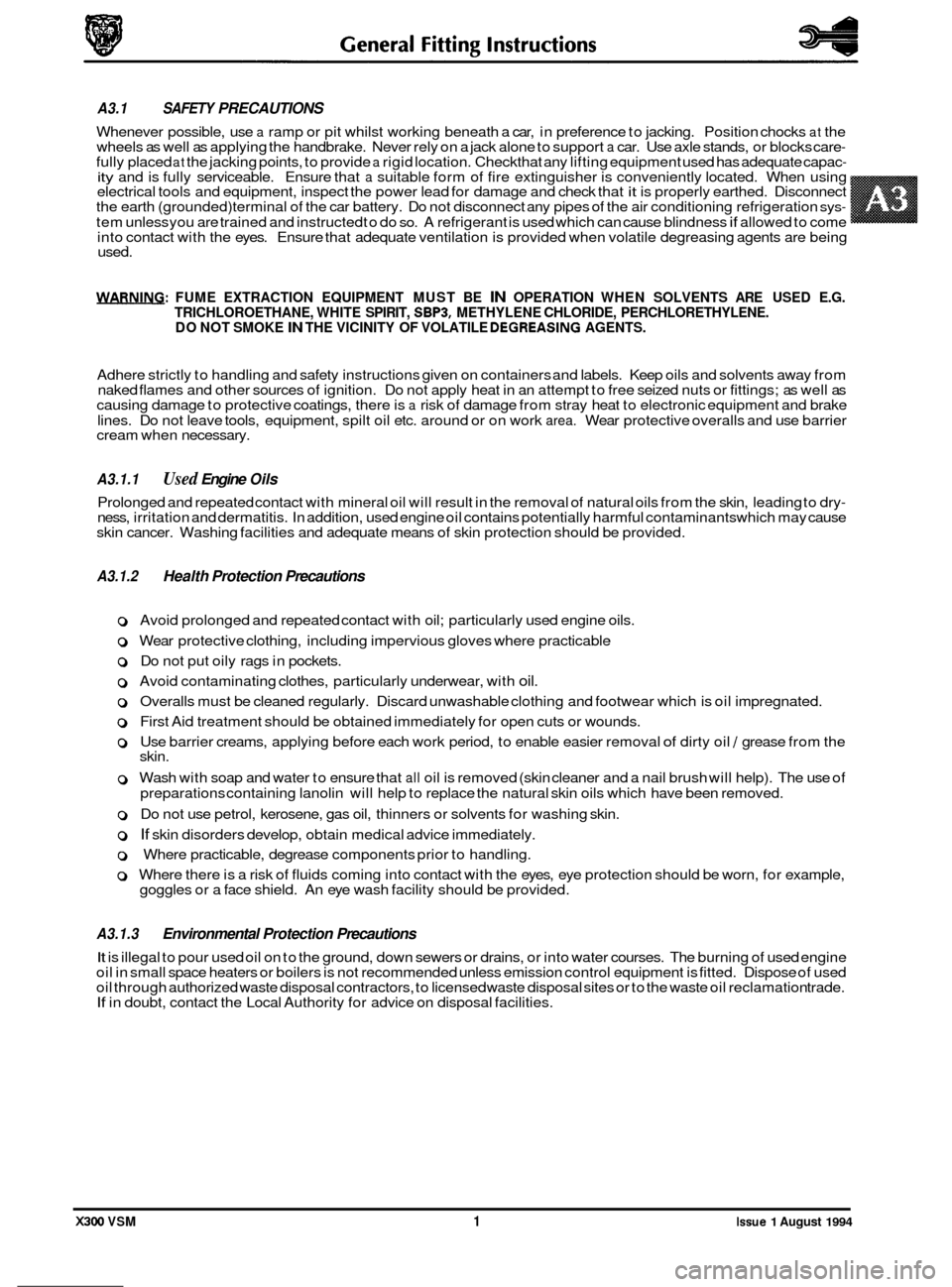
used.
WARNING: FUME EXTRACTION EQUIPMENT MUST BE IN OPERATION WHEN SOLVENTS ARE USED E.G.
TRICHLOROETHANE, WHITE SPIRIT, SBPB, METHYLENE CHLORIDE, PERCHLORETHYLENE.
DO NOT SMOKE IN THE VICINITY OF VOLATILE DEGREASING AGENTS.
Adhere strictly to handling and safety instructions given on containers and labels. Keep oils and solvents away from
naked flames and other sources of ignition. Do not apply heat in an attempt to free seized nuts or fittings; as well as
causing damage to protective coatings, there is
a risk of damage from stray heat to electronic equipment and brake
lines. Do not leave tools, equipment, spilt oil etc. around or on work
area. Wear protective overalls and use barrier
cream when necessary.
0 A3.1.1 Used Engine Oils
Prolonged and repeated contact with mineral oil will result in the removal of natural oils from the skin, leading to dry- ness, irritation and dermatitis. In addition, used engine oil contains potentially harmful contaminants which may cause
skin cancer. Washing facilities and adequate means of skin protection should be provided.
A3.1.2 Health Protection Precautions
0 Avoid prolonged and repeated contact with oil; particularly used engine oils.
o Wear protective clothing, including impervious gloves where practicable
0 Do not put oily rags in pockets.
0 Avoid contaminating clothes, particularly underwear, with oil.
0 Overalls must be cleaned regularly. Discard unwashable clothing and footwear which is oil impregnated.
o First Aid treatment should be obtained immediately for open cuts or wounds.
0 Use barrier creams, applying before each work period, to enable easier removal of dirty oil / grease from the
skin.
0 Wash with soap and water to ensure that all oil is removed (skin cleaner and a nail brush will help). The use of
preparations containing lanolin will help to replace the natural skin oils which have been removed.
o Do not use petrol, kerosene, gas oil, thinners or solvents for washing skin.
0 If skin disorders develop, obtain medical advice immediately.
0 Where practicable, degrease components prior to handling.
0 Where there is a risk of fluids coming into contact with the eyes, eye protection should be worn, for example,
goggles or a face shield. An eye wash facility should be provided.
A3.1.3 Environmental Protection Precautions
A3.1 SAFETY PRECAUTIONS
Whenever possible, use a ramp or pit whilst working beneath a car, in preference to jacking. Position chocks at the
wheels as well as applying the handbrake. Never rely on a jack alone to support a car. Use axle stands, or blocks care- fully placed at the jacking points, to provide a rigid location. Checkthat any lifting equipment used has adequate capac- ity and is fully serviceable. Ensure that a suitable form of fire extinguisher is conveniently located.
When using
electrical tools and equipment, inspect the power lead for damage and check that it is properly earthed. Disconnect
the earth (grounded) terminal of the car battery. Do not disconnect any pipes of the air conditioning refrigeration sys-
tem unless you are trained and instructed to do so. A refrigerant is used which can cause blindness if allowed to come
into contact with the eyes. Ensure that adequate ventilation is provided when volatile degreasing agents are being
It is illegal to pour used oil on to the ground, down sewers or drains, or into water courses. The burning of used engine
oil in small space heaters or boilers is not recommended unless emission control equipment is fitted. Dispose of used
oil through authorized waste disposal contractors, to licensed waste disposal sites or to the waste oil reclamation trade.
If in doubt, contact the Local Authority for advice on disposal facilities.
X300 VSM 1 Issue 1 August 1994
Page 413 of 521
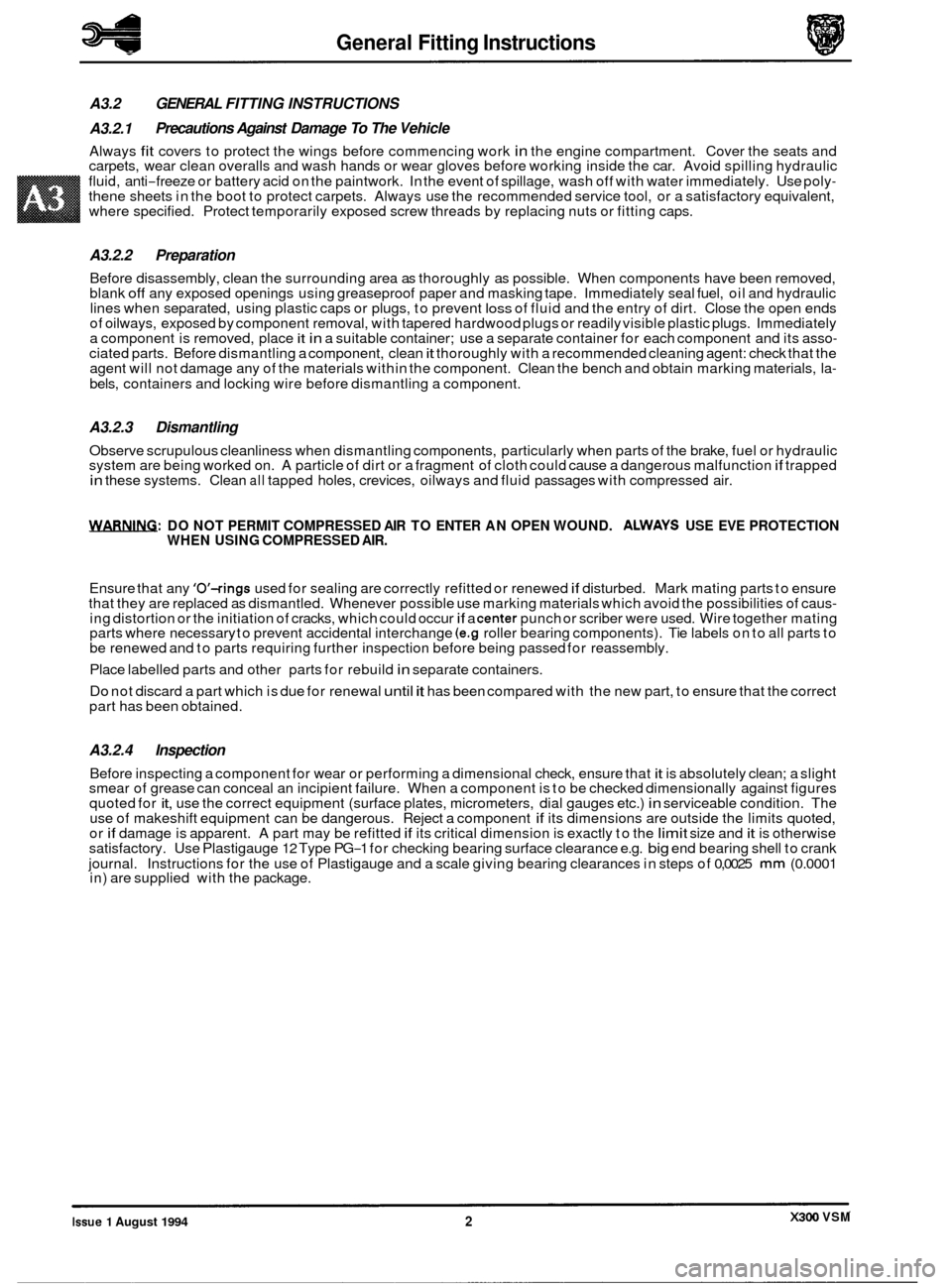
General Fitting Instructions
A3.2 GENERAL FITTING INSTRUCTIONS
A3.2.1
Always fit covers to protect the wings before commencing work in the engine compartment. Cover the seats and
carpets, wear clean overalls and wash hands or wear gloves before working inside the car. Avoid spilling hydraulic
fluid, anti
-freeze or battery acid on the paintwork. In the event of spillage, wash off with water immediately. Use poly- thene sheets in the boot to protect carpets. Always use the recommended service tool, or a satisfactory equivalent,
where specified. Protect temporarily exposed screw threads by replacing nuts or fitting caps.
Precautions Against Damage To The Vehicle
A3.2.2 Preparation
Before disassembly, clean the surrounding area as thoroughly as possible. When components have been removed,
blank off any exposed openings using greaseproof paper and masking tape. Immediately seal fuel, oil and hydraulic
lines when separated, using plastic caps or plugs, to prevent loss of fluid and the entry of dirt. Close the open ends
of oilways, exposed by component removal, with tapered hardwood plugs or readily visible plastic plugs. Immediately
a component is removed, place
it in a suitable container; use a separate container for each component and its asso- ciated parts. Before dismantling a component, clean it thoroughly with a recommended cleaning agent: check that the
agent will not damage any of the materials within the component. Clean the bench and obtain marking materials, la-
bels, containers and locking wire before dismantling a component.
A3.2.3 Dismantling
Observe scrupulous cleanliness when dismantling components, particularly when parts of the brake, fuel or hydraulic
system are being worked on. A particle of dirt or a fragment of cloth could cause a dangerous malfunction if trapped in these systems. Clean all tapped holes, crevices, oilways and fluid passages with compressed air.
WRNIFLG: DO NOT PERMIT COMPRESSED AIR TO ENTER AN OPEN WOUND. ALWAYS USE EVE PROTECTION
WHEN USING COMPRESSED AIR.
Ensure that any 'O'-rings used for sealing are correctly refitted or renewed if disturbed. Mark mating parts to ensure
that they are replaced as dismantled. Whenever possible use marking materials which avoid the possibilities of caus- ing distortion or the initiation of cracks, which could occur if a center punch or scriber were used. Wire together mating
parts where necessary to prevent accidental interchange (e.g roller bearing components). Tie labels on to all parts to
be renewed and to parts requiring further inspection before being passed for reassembly.
Place labelled parts and other parts for rebuild
in separate containers.
Do not discard a part which is due for renewal until it has been compared with the new part, to ensure that the correct
part has been obtained.
A3.2.4 Inspection
Before inspecting a component for wear or performing a dimensional check, ensure that it is absolutely clean; a slight
smear of grease can conceal an incipient failure. When a component is to be checked dimensionally against figures
quoted for
it, use the correct equipment (surface plates, micrometers, dial gauges etc.) in serviceable condition. The
use of makeshift equipment can be dangerous. Reject a component if its dimensions are outside the limits quoted,
or if damage is apparent. A part may be refitted if its critical dimension is exactly to the limit size and it is otherwise
satisfactory. Use Plastigauge 12 Type PG-1 for checking bearing surface clearance e.g. big end bearing shell to crank
journal. Instructions for the use of Plastigauge and a scale giving bearing clearances in steps of
0,0025 mm (0.0001
in) are supplied with the package.
0
0
0
X300 VSM Issue 1 August 1994 2
Page 414 of 521

in these areas indicates the onset of wear.
Hold the inner race between the fingers and thumb of one hand, spin the outer race and checkthat
it revolves absolutely
smoothly. Rotate the outer ring with a reciprocating motion, while holding the inner ring; feel for any obstruction to
rotation and reject the bearing if the action is not perfectly smooth. Lubricate the bearing generously with lubricant
appropriate to the installation. Inspect the shaft and bearing housing for discolouration or other marking which may
suggest that movement has taken place between the bearing and bearing seat.
If markings are found, use Loctite when
installing the replacement bearing.
Ensure that the shaft and housing
are clean and free from
burrs before fitting the bearing. If one bearing of a pair
shows an imperfection, it is generally advisable to renew
both bearings: an exception could be made only if the bear- ings had covered a low mileage and it could be established
that damage was confined to the one bearing.
- In the case of bearings which are lubricated with grease (e.g.
hub bearings) the space between the bearings should be
smeared with a recommended grade of grease, and the
bearings and seal should be re
-packed. When fitting the
bearing to the shaft, apply force only to the inner ring of
bearing (Fig.
1A). When fitting the bearing to the housing,
apply force only to outer ring (Fig. 1B).
Always mark components of separable bearings (e.g taper
roller bearings) when dismantling, to ensure correct
reassembly. Never
fit a new inner roller assembly to a used
outer track.
A3.2.6 Oil Seals
Always fit new oil seals when rebuilding an assembly.
Examine the seal before fitting to ensure that it is clean and
undamaged. Smear sealing lips with clean grease, pack
dust excluder seals with grease and pack grease into the
cavity between the sealing lips of duplex seals. Ensure that
the seal spring,
if provided, is correctly fitted.
Place the lip
of the seal towards the fluid to be sealed and
slide it into position on the shaft, using a fitting sleeve (Fig. 2) when possible to protect the sealing lip from damage by
threads, splines or sharp edges on the end of the shaft. If a fitting sleeve is not available, use plastic tube or adhesive
tape to prevent damage to the sealing lip.
Grease the outside diameter of the seal, place it square to the
housing recess and press it into position, using great care
and, where available, a seal installer (Fig. 3) to ensure that
the seal does not tilt. In some cases it may be preferable to
fit the seal to the housing before fitting it to the shaft. Never
let the weight of an unsupported shaft rest in a seal. If the
correct service tool is not available, use a piece of tube which
is approximately 0,4 mm (0.015 in) smaller than the outside
diameter of the seal. Use a press to install the seal or use a
hammer VERY GENTLY on the tubular drift if a press is un-
suitable or not available.
,107 001 A B
I Fig. 1
A3.2.5 Ball And Roller Bearings
CAUTION: Never replace a ball or roller bearing without first ensuring that it is in as-new condition.
Remove
all traces of lubricant from the bearing by washing it in petrol or a suitable degreaser. Maintain absolute
cleanliness throughout the operations. Inspect visually for markings of any form on rolling elements, bearing tracks,
outer surface of outer rings or inner surface of inner rings. Reject any bearings found to be marked, since any markings
Fig.
2
307 002
i
Fig. 3
Issue 1 August 1994 3 X300 VSM
Page 415 of 521
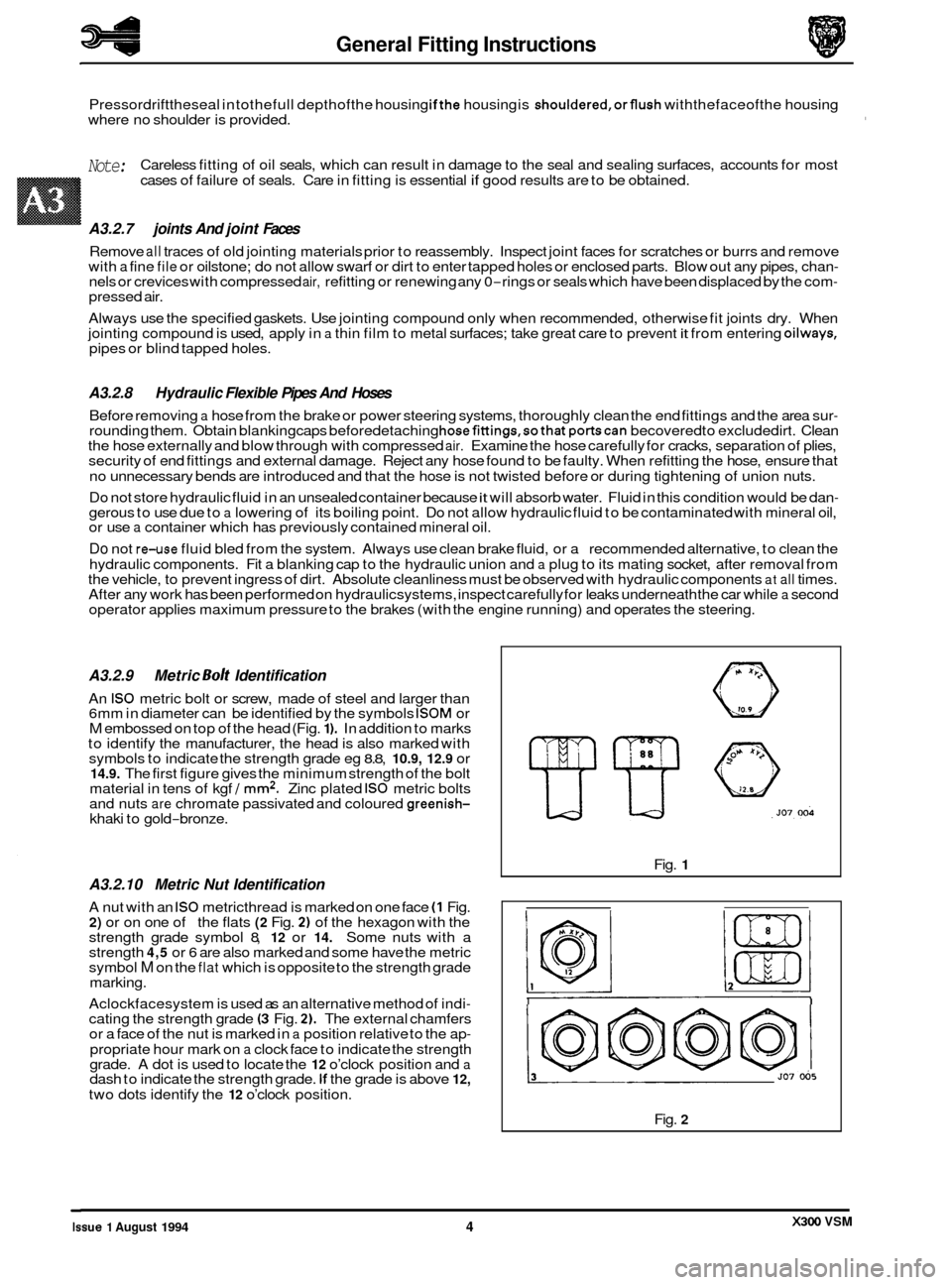
General Fitting Instructions
Pressordrifttheseal in tothefull depthofthe housing ifthe housing is shouldered,orflush withthefaceofthe housing
where no shoulder is provided.
Note: Careless fitting of oil seals, which can result in damage to the seal and sealing surfaces, accounts for most
cases of failure of seals. Care in fitting is essential
if good results are to be obtained.
A3.2.7 joints And joint Faces
Remove all traces of old jointing materials prior to reassembly. Inspect joint faces for scratches or burrs and remove
with a fine file or oilstone; do not allow swarf or dirt to enter tapped holes or enclosed parts. Blow out any pipes, chan- nels or crevices with compressed air, refitting or renewing any 0-rings or seals which have been displaced by the com- pressed air.
Always use the specified gaskets. Use jointing compound only when recommended, otherwise fit joints dry. When
jointing compound is used, apply in
a thin film to metal surfaces; take great care to prevent it from entering oilways, pipes or blind tapped holes.
A3.2.8
Before removing a hose from the brake or power steering systems, thoroughly clean the end fittings and the area sur- rounding them. Obtain blanking caps beforedetaching hosefittings,sothat portscan becovered to excludedirt. Clean
the hose externally and blow through with compressed air. Examine the hose carefully for cracks, separation of plies,
security of end fittings and external damage. Reject any hose found to be faulty. When refitting the hose, ensure that
no unnecessary bends are introduced and that the hose is not twisted before or during tightening of union nuts.
Do not store hydraulic fluid in an unsealed container because it will absorb water. Fluid in this condition would be dan- gerous to use due to a lowering of its boiling point. Do not allow hydraulic fluid to be contaminated with mineral oil,
or use a container which has previously contained mineral oil.
Do not re-use fluid bled from the system. Always use clean brake fluid, or a recommended alternative, to clean the
hydraulic components. Fit a blanking cap to the hydraulic union and
a plug to its mating socket, after removal from
the vehicle, to prevent ingress of dirt. Absolute cleanliness must be observed with hydraulic components at all times.
After any work has been performed on hydraulicsystems, inspect carefully for leaks underneath the car while a second
operator applies maximum pressure to the brakes (with the engine running) and operates the steering.
Hydraulic Flexible Pipes And Hoses
A3.2.9 Metric
Bolt Identification
An IS0 metric bolt or screw, made of steel and larger than
6mm in diameter can be identified by the symbols ISOM or M embossed on top of the head (Fig. 1 ). In addition to marks
to identify the manufacturer, the head is also marked with
symbols to indicate the strength grade eg
8.8, 10.9, 12.9 or 14.9. The first figure gives the minimum strength of the bolt
material in tens of kgf / mm2. Zinc plated IS0 metric bolts
and nuts are chromate passivated and coloured greenish- khaki to gold-bronze.
A3.2.10 Metric Nut Identification
A nut with an IS0 metricthread is marked on one face (1 Fig. 2) or on one of the flats (2 Fig. 2) of the hexagon with the
strength grade symbol 8, 12 or 14. Some nuts with a
strength 4,5 or 6 are also marked and some have the metric
symbol M on the flat which is opposite to the strength grade
marking.
Aclockfacesystem is used as an alternative method of indi
- cating the strength grade (3 Fig. 2). The external chamfers
or a face of the nut is marked in a position relative to the ap-
propriate hour mark on a clock face to indicate the strength
grade. A dot is used to locate the 12 o’clock position and a dash to indicate the strength grade. If the grade is above 12,
two dots identify the 12 o’clock position. Fig.
1
I I
Fig. 2
X300 VSM Issue 1 August 1994 4
Page 416 of 521
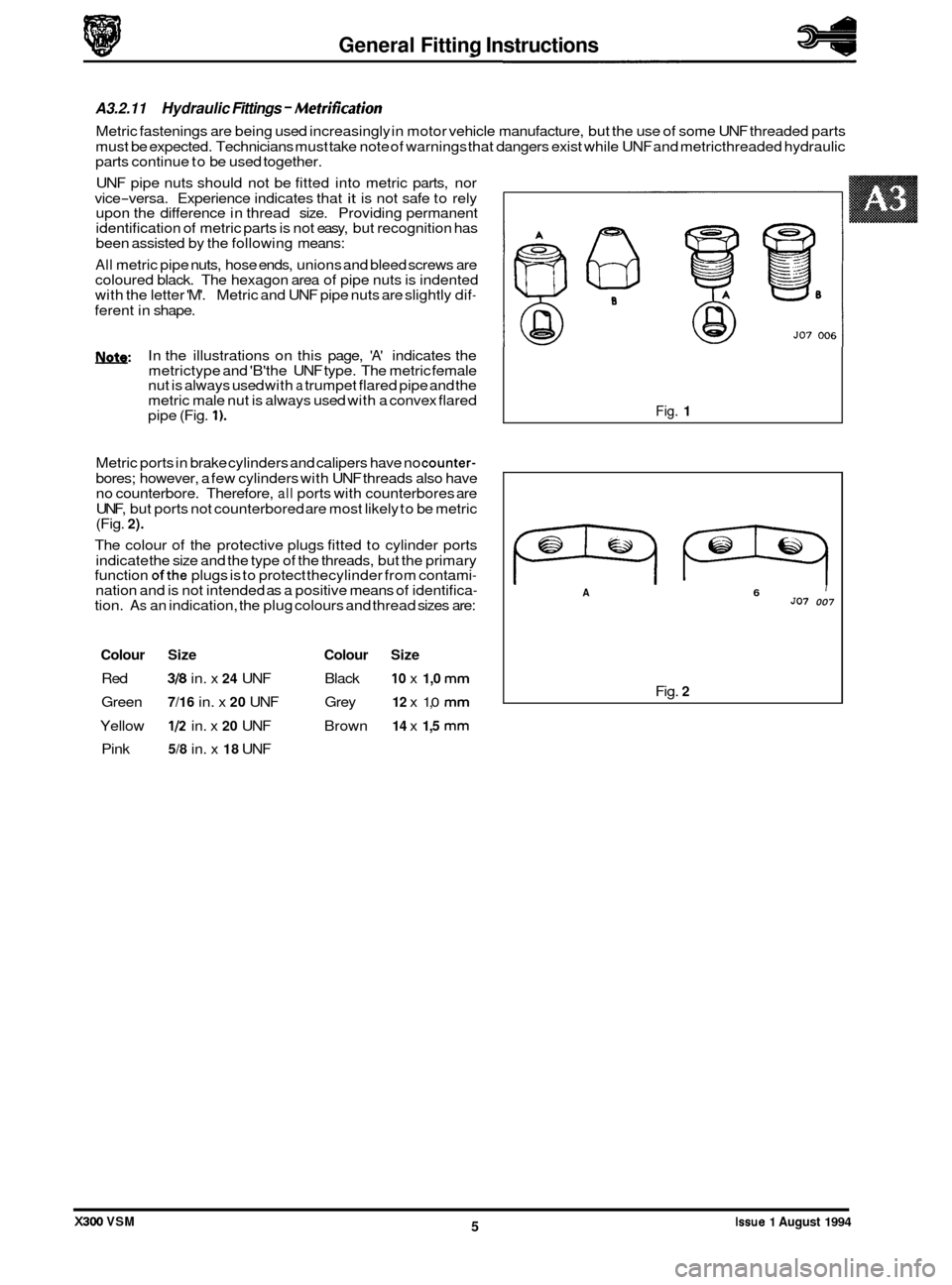
General Fitting Instructions
Issue 1 August 1994 5 X300 VSM I
0
0
0
0
A3.2.11 Hydraulic Fittings - Metrification
Metric fastenings are being used increasingly in motor vehicle manufacture, but the use of some UNF threaded parts
must be expected. Technicians must take note of warnings that dangers exist while UNF and metricthreaded hydraulic
parts continue to be used together.
UNF pipe nuts should not be fitted into metric parts, nor
vice
-versa. Experience indicates that it is not safe to rely
upon the difference in thread size. Providing permanent
identification of metric parts is not easy, but recognition has
been assisted by the following means:
All metric pipe nuts, hose ends, unions and bleed screws are
coloured black. The hexagon area of pipe nuts is indented
with the letter 'M'. Metric and UNF pipe nuts are slightly dif
-
ferent in shape.
hlnfe: In the illustrations on this page, 'A' indicates the
metrictype and 'B'the UNF type. The metric female
nut is always used with
a trumpet flared pipe and the
metric male nut is always used with a convex flared
pipe (Fig.
1).
Metric ports in brake cylinders and calipers have no counter-
bores; however, a few cylinders with UNF threads also have
no counterbore. Therefore, all ports with counterbores are
UNF, but ports not counterbored are most likely to be metric
(Fig.
2).
The colour of the protective plugs fitted to cylinder ports
indicate the size and the type of the threads, but the primary
function
ofthe plugs is to protect thecylinder from contami- nation and is not intended as a positive means of identifica- tion. As an indication, the plug colours and thread sizes are:
Colour Size Colour Size
Red 318 in. x 24 UNF Black 10 x 1,0 mm
Green 7/16 in. x 20 UNF Grey 12 x 1,0 mm
Yellow 112 in. x 20 UNF Brown 14 x 1,5 mm
Pink 5/8 in. x 18 UNF
Fig. 1
A 6 I 507 007
Fig. 2
Page 417 of 521
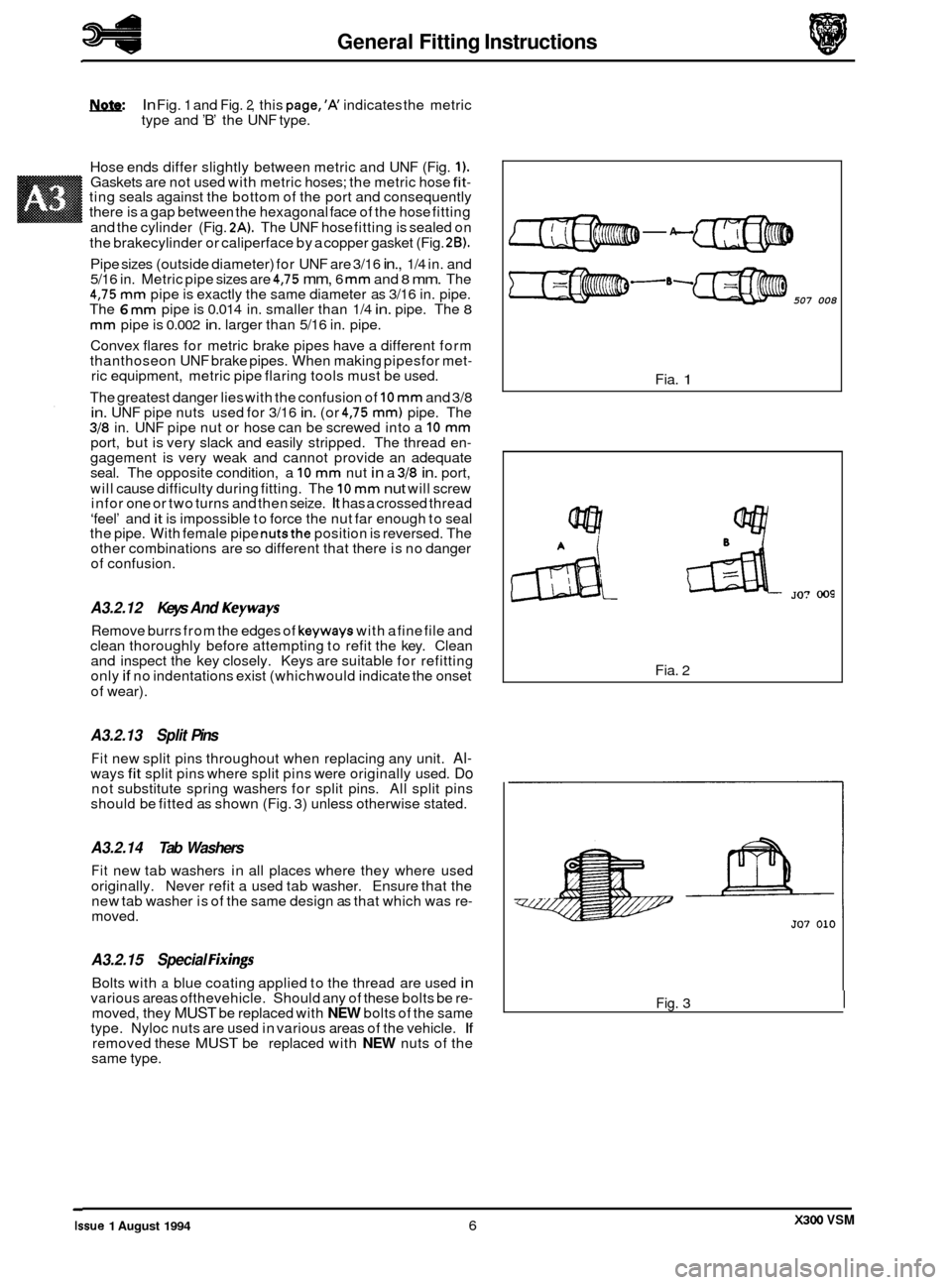
General Fitting Instructions
In Fig. 1 and Fig. 2, this page,’K indicates the metric
type and ’B’ the UNF type.
Hose ends differ slightly between metric and UNF (Fig.
1). Gaskets are not used with metric hoses; the metric hose fit- ting seals against the bottom of the port and consequently
there is a gap between the hexagonal face of the hose fitting
and the cylinder (Fig.
2A). The UNF hose fitting is sealed on
the brakecylinder or caliperface by a copper gasket (Fig.
2B).
Pipe sizes (outside diameter) for UNF are 3/16 in., 1/4 in. and
5/16 in. Metric pipe sizes are 4,75 mm, 6 mm and 8 mm. The 4,75 mm pipe is exactly the same diameter as 3/16 in. pipe.
The 6 mm pipe is 0.014 in. smaller than 1/4 in. pipe. The 8
mm pipe is 0.002 in. larger than 5/16 in. pipe.
Convex flares for metric brake pipes have a different form
thanthoseon UNF brake pipes. When making pipesfor met
- ric equipment, metric pipe flaring tools must be used.
The greatest danger lies with the confusion of
10 mm and 3/8 in. UNF pipe nuts used for 3/16 in. (or 4,75 mm) pipe. The 318 in. UNF pipe nut or hose can be screwed into a 10 mm port, but is very slack and easily stripped. The thread en- gagement is very weak and cannot provide an adequate
seal. The opposite condition, a 10 mm nut in a 318 in. port,
will cause difficulty during fitting. The
10 mm nut will screw
in for one or two turns and then seize. It has a crossed thread
‘feel’ and
it is impossible to force the nut far enough to seal
the pipe. With female pipe nutsthe position is reversed. The
other combinations are so different that there is no danger
of confusion.
A3.2.12 Keys And Keyways
Remove burrs from the edges of keyways with a fine file and
clean thoroughly before attempting to refit the key. Clean
and inspect the key closely. Keys are suitable for refitting
only
if no indentations exist (which would indicate the onset
of wear).
A3.2.13 Split Pins
Fit new split pins throughout when replacing any unit. Al- ways fit split pins where split pins were originally used. Do not substitute spring washers for split pins. All split pins
should be fitted as shown (Fig. 3) unless otherwise stated.
A3.2.14 Tab Washers
Fit new tab washers in all places where they where used
originally. Never refit a used tab washer. Ensure that the
new tab washer is of the same design as that which was re
- moved.
A3.2.15 Special Fixing
Bolts with a blue coating applied to the thread are used in various areas ofthevehicle. Should any of these bolts be re- moved, they MUST be replaced with NEW bolts of the same
type. Nyloc nuts are used in various areas of the vehicle. If removed these MUST be replaced with NEW nuts of the
same type.
-A
507 008
Fia. 1
Fia. 2
Fig. 3 I
X300 VSM Issue 1 August 1994 6
Page 418 of 521
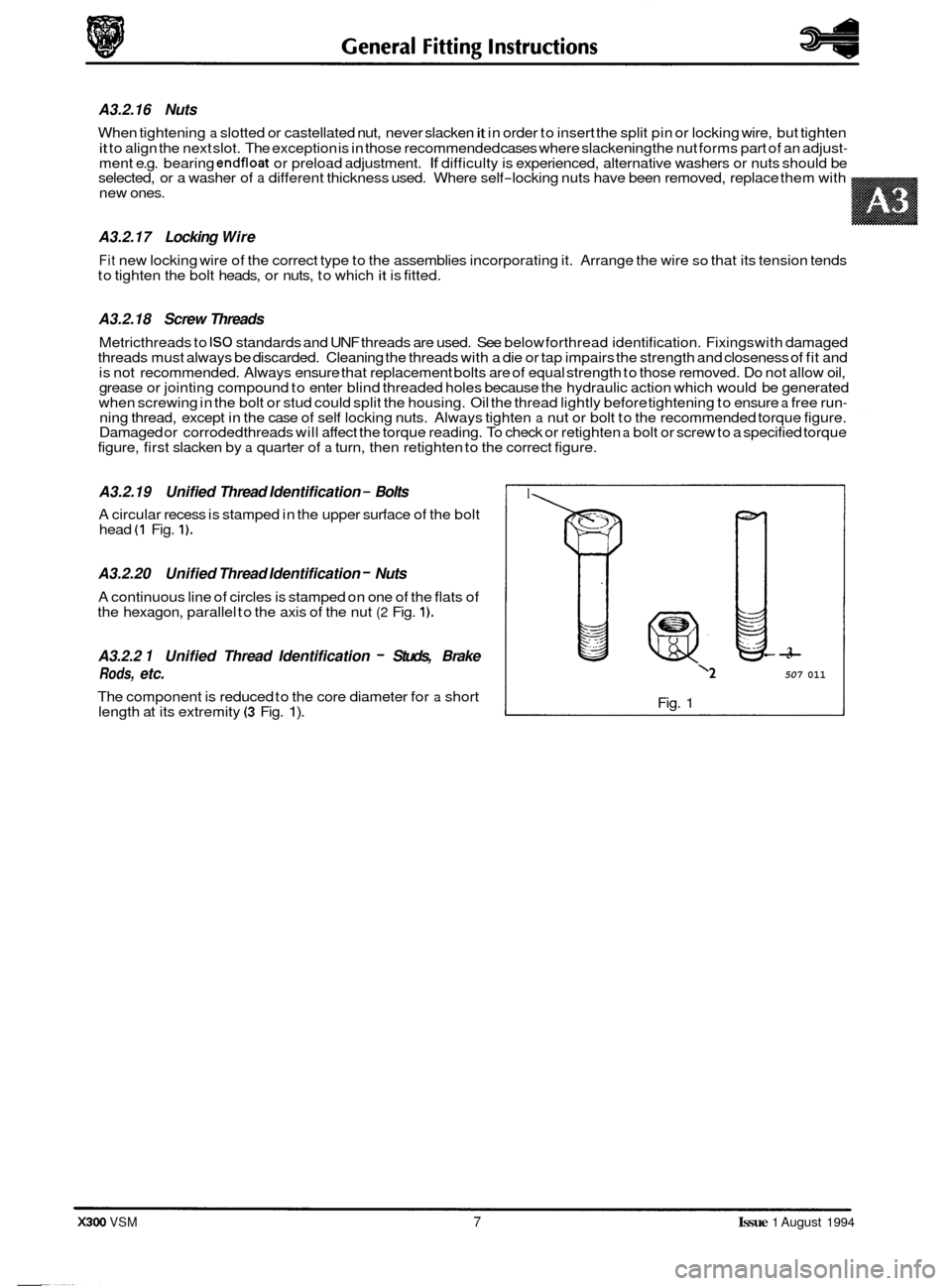
- A3.2.19 Unified Thread Identification - Bolts
A circular recess is stamped in the upper surface of the bolt
head (1 Fig. 1).
A3.2.20 Unified Thread Identification - Nuts
A continuous line of circles is stamped on one of the flats of
the hexagon, parallel to the axis of the nut (2 Fig. 1).
A3.2.2 1 Unified Thread Identification - Studs, Brake
Rods, etc.
The component is reduced to the core diameter for a short
length at its extremity (3 Fig. 1).
A3.2.16 Nuts
When tightening a slotted or castellated nut, never slacken it in order to insert the split pin or locking wire, but tighten
it to align the next slot. The exception is in those recommended cases where slackening the nut forms part of an adjust- ment e.g. bearing endfloat or preload adjustment. If difficulty is experienced, alternative washers or nuts should be
selected, or a washer of a different thickness used. Where self-locking nuts have been removed, replace them with
new ones.
A3.2.17 Locking Wire
Fit new locking wire of the correct type to the assemblies incorporating it. Arrange the wire so that its tension tends
to tighten the bolt heads, or nuts, to which it is fitted.
A3.2.18 Screw Threads
Metricthreads to IS0 standards and UNF threads are used. See below forthread identification. Fixings with damaged
threads must always be discarded. Cleaning the threads with a die or tap impairs the strength and closeness of fit and
is not recommended. Always ensure that replacement bolts are of equal strength to those removed. Do not allow oil,
grease or jointing compound to enter blind threaded holes because the hydraulic action which would be generated
when screwing in the bolt or stud could split the housing. Oil the thread lightly before tightening to ensure
a free run- ning thread, except in the case of self locking nuts. Always tighten a nut or bolt to the recommended torque figure.
Damaged or corroded threads will affect the torque reading. To check or retighten a bolt or screw to a specified torque
figure, first slacken by a quarter of a turn, then retighten to the correct figure.
I
7
-3
‘2 507 011
Fig. 1
X300 VSM 7 Issue 1 August 1994
Page 419 of 521

General Fitting Instructions
J51 051
A3.3 TAPER ROLLER BEARINGS,
FAULT DIAGNOSIS
I
Fault
Bent cage.
Cause
Improper handling or use of tool.
Remedy
Renew the bearing.
Fault
Bent cage.
Cause
Improper handling or use of tool.
Remedy
Renew the bearing.
Fault
Galling.
Cause
Marks on roller ends due to overheating, lubricant failure or
overloading.
Remedy
Renew the bearing. Check the seals and ensure that the
bearing is properly lubricated.
Fault
Step wear.
Cause
Wear on the roller ends caused by fine abrasives.
Remedy
Clean all components and housings. Check the seals and
bearings, and renew if leaking, rough or noisy.
Fault
Fretting.
Cause
Corrosion caused by small movement of components with
no lubrication.
Remedy
Renew the bearing. Check the seals for leakage and ensure
that there is adequate lubrication.
J51 050
J51 052
X300 VSM Issue 1 August 1994 8
Page 420 of 521

6 Fault
Misalignment.
Cause
Outer track misalignment usually due to a foreign body under the track.
Remedy
Clean all components and replace or renew the bearing and
ensure that the new track is correctly seated.
Fault
Indentations.
Cause
Surfaces are depressed on the race and the trackcaused by
hard particles of foreign material.
Remedy
Clean all components and housings. Check the seals and 0 bearings, and renew if leaking, rough or noisy.
r-7 .. ..... .,;, :.'. ,.: __.. ........ .... ..T;....'...':... ...... ........... ,i ........ :;: .. .-.. .... : ........ - ..
1 056
Fault
Flaking.
Cause
Flaking of the surface material due to fatigue.
Remedy
Renew the bearing and clean all related components.
Fault
Indentations.
Cause
Surface indentations in the track caused by rollers either
vibrating or impact loading while the bearing is not rotating.
Remedy
Renew the bearing if rough or noisy.
Fault
Cage wear.
Cause
Wear around the outside diameter of the cage and roller
pockets caused by poor lubrication and abrasive material.
Remedy
Renew the bearings and check the condition of the seals.
J51058
Issue 1 August 1994 9 X300 VSM